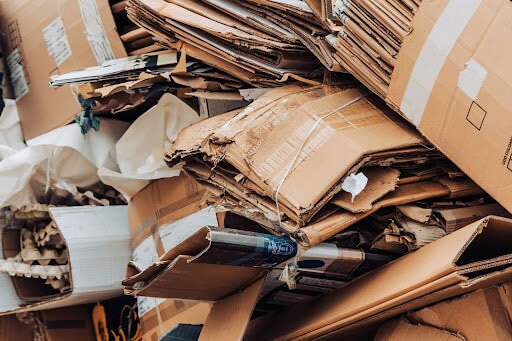
TLDR
Paper waste refers to discarded paper materials that are no longer needed and are destined for disposal. Paper waste is a significant environmental concern due to its contribution to landfills, deforestation, energy and water consumption, and air pollution.
In the swirl of today’s bustling world, paper remains a silent yet significant part of our daily lives. From the morning coffee cup to the endless stream of office documents, paper is omnipresent, often overlooked yet highly impactful on the environment. The reality is stark: paper waste constitutes a major segment of the solid waste in landfills and plays a notable role in deforestation, greenhouse gas emissions, and pollution.
So understanding how to reduce paper waste and taking actionable steps to minimize it isn't just an act of environmental consciousness; it's a responsibility. Today, we explore the labyrinth of paper waste, its repercussions, and how eco-friendly alternatives can significantly contribute to curbing this issue.
The Current State of Paper Waste
Despite the sea of digital transformation, paper endures as an integral yet challenging element of our global waste dilemma. Despite our lives becoming increasingly centered on digital solutions, the trails of wastepaper continue to expand, suggesting that the paperless world we often continue to imagine as the wave of the future remains elusive.
From school assignments to boardroom reports, the demand for paper is juxtaposed against the urgent call for environmental stewardship. As we delve into the realm of how to reduce paper waste, it’s clear that our reliance on this resource has significant repercussions, necessitating a closer look at recovery, recycling, and the role of paper in our daily professional activities.
Global Paper Recovery and Recycling
The path of paper from creation to recycling is a complex one, often stymied by insufficient recycling infrastructure and the mixed quality of the recovered material. Despite considerable progress, a substantial gap exists between the amount of paper produced and the quantities that are reclaimed and repurposed.
Efforts to enhance paper recovery and recycling are ongoing, with the ultimate goal being a closed-loop system where paper and packaging waste re-enters the production cycle, minimizing the need for raw materials. These endeavors are not just about preserving trees; they're about creating a sustainable model that can support our paper needs without compromising the health of our planet.
The Impact of Paper in Offices and Industries
Paper serves as both a tool of communication and a symbol of bureaucracy. Offices, while pivoting towards digital solutions, still harbor a significant dependency on paper, evident in the towering stacks of documents, reports, and promotional materials that accumulate and need sorting daily. This continuous churn of paper contributes to an enormous waste footprint, one that industries are now seeking to reduce through innovative waste reduction strategies and responsible sourcing.
Efforts such as encouraging responsible paper usage, maximizing waste paper recycling within the corporate structure, and practicing overall sustainability in the workplace are becoming more prevalent as businesses awaken to the economic and environmental benefits of waste minimization.
The Environmental and Economic Consequences of Paper Waste
Paper waste is not a silent issue; its environmental ramifications echo through the corridors of economic and ecological discussions alike. Its consequences ripple out, affecting forests, the air we breathe, and the efficiency of our waste management systems. Understanding the full impact of paper waste is a step towards mitigating its effects and crafting solutions that align with our environmental aspirations and economic realities.
Greenhouse Gas Emissions
The paper industry's contribution to greenhouse gasses is a significant facet of its environmental impact, with both the U.S. and Canada grappling with the implications of climate change.1 This sector is among the top industrial emitters of carbon dioxide, the byproduct of energy consumption for paper processing and transportation. Every ton of paper recycled can prevent the release of approximately one ton of carbon dioxide, illustrating the profound climate benefits that can be achieved through improved recycling rates and reduced paper production.
Deforestation and Its Effects
Deforestation, driven by various industries including paper and pulp, continues to be an alarming global issue. It not only contributes to the loss of biodiversity and the displacement of indigenous communities but also exacerbates climate change by reducing the planet's carbon absorption capacity. Encouragingly, each ton of recycled paper can save approximately 17 trees, underscoring the critical role that recycling can play in mitigating the ecological impact of deforestation and promoting sustainable forest management practices.
Landfill Challenges and Pollution
The voluminous amount of paper waste that ends up in landfills presents a two-fold challenge: it occupies valuable land and, as it decomposes, produces methane, a potent greenhouse gas. Moreover, the financial burden of managing these landfills falls on taxpayers, who often unknowingly subsidize these costs through municipal waste management fees. Reducing paper waste not only conserves landfill space but also diminishes the financial strain on communities working to manage an ever-growing tide of paper and cardboard waste.
Practical Solutions to Reduce Paper Waste
Reducing paper waste aligns with the principles of reducing, reusing, and recycling, which are pivotal for creating a sustainable future. It involves not only changing individual behaviors and office practices but also embracing innovative technologies that offer paperless alternatives.
By taking proactive steps to minimize paper consumption, we can significantly diminish the environmental footprint of our daily activities and contribute to the conservation of natural resources. Moreover, such actions often lead to increased efficiency and cost savings, creating a compelling case for individuals and businesses alike to adjust their paper usage habits.
Mindful Printing
Becoming more mindful about printing can dramatically reduce unnecessary printer paper use. Simple actions such as printing only what is essential or utilizing print preview to avoid mistakes can cut down on office paper waste significantly. In addition to efficient document formatting and advocating for double-sided printing, office settings can promote a culture of mindfulness where each sheet of paper is valued, and printing is approached with intention, not as an automatic reflex.
Embracing the Digital Age
The digital revolution offers a powerful tool in the fight against paper waste. The move toward paperless billing, online subscriptions, and electronic data storage has already shown significant reductions in paper usage. Utilizing cloud-based services and collaborative platforms can not only eliminate the need for physical documents but also increase operational efficiency making the paperless route an attractive option for both environmental and productivity gains.
Creative Reuse and Recycling
Recycling should be a last resort after all efforts to reduce and reuse have been considered. Encouraging creative reuse of old paper, such as using the blank side of printed papers for notes or making multiple use of cardboard boxes, contributes to the reduction of waste. Moreover, when recycling is necessary, doing it properly by ensuring papers are free of contaminants and sorted correctly can maximize the effectiveness of recycling programs and support the industry's shift towards utilizing more post-consumer waste and recycled fiber in new paper production.
The Reel Paper Difference
With its innovative approach, Reel Paper serves as a means to push sustainability in an industry that is often criticized for its environmental impact. By offering bamboo-based and recycled household paper products such as bamboo toilet paper, recycled facial tissues, and sustainable paper towels, Reel Paper provides consumers with high-quality, eco-friendly alternatives to traditional paper products.
This commitment extends beyond just the materials used; our brand’s entire business model is rooted in environmental responsibility and social welfare, including plastic-free packaging and partnerships with initiatives to improve access to clean sanitation worldwide.
By choosing Reel Paper, customers are not only making a choice that benefits the planet but are also joining a movement that supports global sustainability and hygiene programs, creating a ripple effect of positive change.
References:
- GHGRP Pulp and Paper | US EPA 2016 URL: https://www.epa.gov/ghgreporting/ghgrp-pulp-and-paper
- Pulp & paper | IEA 2023 URL: https://www.iea.org/energy-system/industry/paper
- Paper Recycling as a Means of Protecting World Forests By Renée Yardley |Sustainable Brands 2019 URL: https://sustainablebrands.com/read/corporate-member-update/paper-recycling-as-a-means-of-protecting-world-forests



0 comments